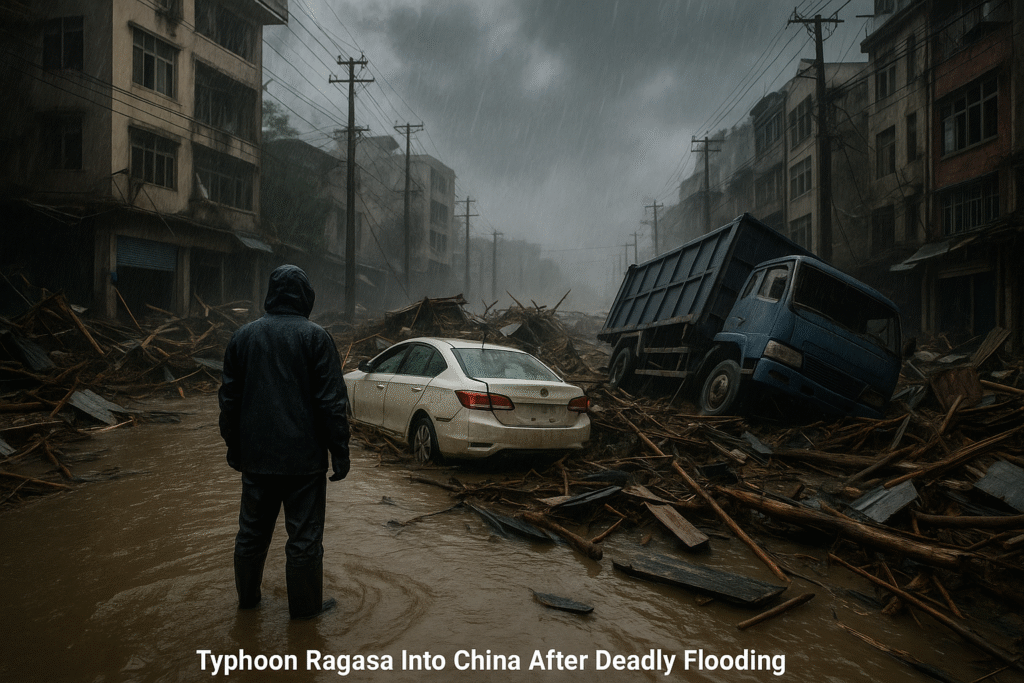By Harshit | September 24, 2025 | Beijing, China | 9:30 PM CST
Millions Evacuated as China Braces for “King of Storms”
Typhoon Ragasa, the strongest storm of 2025, has made landfall in southern China after carving a deadly path across Taiwan. Authorities confirmed that around two million people were evacuated ahead of the storm’s arrival, as coastal regions braced for destructive winds and torrential rain.
The typhoon, downgraded from super to severe status, is still packing maximum sustained winds of 241 km/h (150 mph), equivalent to a Category Five hurricane. Meteorologists have labeled it “the King of Storms” due to its immense scale and power, which has been building over the South China Sea for days.
Taiwan Disaster: Lake Burst Causes Deadly Flooding
Before reaching China, Ragasa left a trail of destruction in Taiwan, where at least 17 people were killed after a lake burst in the island’s eastern region. Geologists described the sudden flooding as a “tsunami from the mountains,” as walls of water surged into communities, washing away homes and infrastructure.
Rescue teams continue to search for survivors, with helicopters and boats deployed to reach isolated villages. Roads and bridges were destroyed, complicating emergency relief efforts. Taiwan’s authorities warned that the final death toll may rise as more areas become accessible.
Zhuhai Faces Torrential Rainfall
In mainland China, Zhuhai city is expected to bear the brunt of Ragasa. Weather officials project that the region could receive a month’s worth of rain in just one day. Local correspondent Laura Bicker reported scenes of shuttered businesses, empty streets, and residents sheltering in government evacuation centers.
Authorities have activated their highest-level emergency response, deploying troops, disaster-relief personnel, and medical teams across the affected provinces. Dams and reservoirs are being closely monitored amid fears of additional flooding.
Hong Kong Spared Direct Hit but Not Impact
Though Ragasa did not make direct landfall in Hong Kong, the city endured violent winds and heavy downpours as the storm skirted the coastline. Officials confirmed that 62 people were injured during the storm, mostly from falling debris and accidents caused by gale-force winds. Public transport was briefly suspended, schools were closed, and flights were canceled before conditions began to stabilize.
International and Regional Response
Chinese President Xi Jinping has called for “all-out rescue and relief efforts” to minimize casualties and damage, pledging government support to rebuild affected areas. Meanwhile, Taiwan has requested international assistance, particularly in heavy equipment and flood control systems, to help stabilize regions hit by the mountain lake disaster.
Aid organizations have warned that the combination of landslides, collapsed infrastructure, and ongoing heavy rainfall poses long-term risks for both Taiwan and China. Relief groups are particularly concerned about drinking water contamination and the spread of waterborne diseases in crowded evacuation shelters.
Climate and Storm Trends
Ragasa’s intensity adds to growing scientific concerns about the increasing frequency of super typhoons in the Pacific. Warmer sea surface temperatures and shifting climate patterns are believed to be fueling stronger and more destructive storms.
“This is a textbook example of how climate change amplifies the risks from tropical cyclones,” said meteorologist Dr. Chen Wei of the Chinese Academy of Sciences. “We are seeing higher wind speeds, more rainfall, and greater flooding potential than storms of similar magnitude from decades ago.”
Looking Ahead
While Ragasa has weakened slightly, forecasters warn that it will continue to batter inland regions of Guangdong and Guangxi provinces with dangerous rainfall, storm surges, and landslides. Authorities urged residents not to return home until given clearance, citing the potential for aftereffects such as flash floods and dam breaches.
The typhoon’s devastating impact across both Taiwan and China has underscored the vulnerability of coastal and mountainous communities to extreme weather. As recovery begins, Ragasa is already being described as one of the most destructive storms in recent memory.







